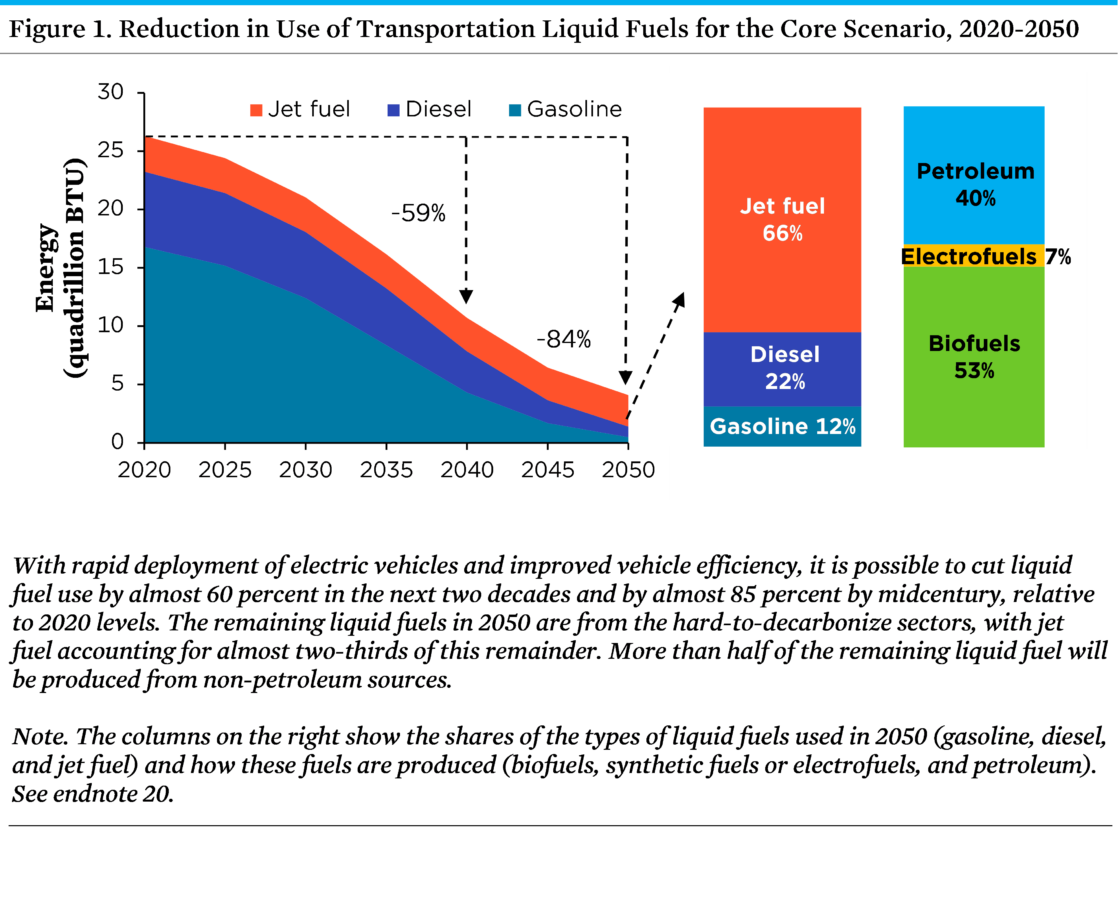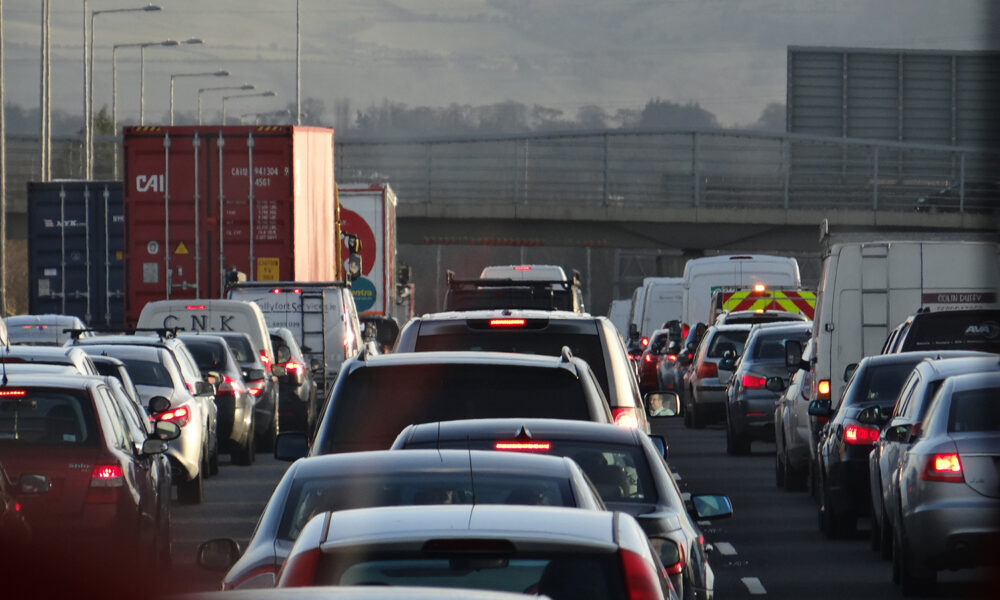In a study from the Union of Concerned Scientists (UCS) in collaboration with consulting firm Evolved Energy Research (EER) and an expert advisory committee, we show that the United States can drastically reduce global warming emissions by replacing a highly polluting transportation sector, powered today primarily with petroleum-based fuels, with a cleaner, more efficient and more equitable system powered primarily by renewable electricity. This transition will require rapid vehicle electrification and lead to a phaseout of petroleum, and can be achieved at modest cost, with growth in new parts of the economy. Replacing petroleum with renewable electricity as the primary source of transportation energy will leave us all much better off.
The impacts of climate change are upon us, a consequence of over a century of global warming emissions from human activity. Moving people and goods around in the United States contributes to 29 percent of emissions, the largest share in the economy. An average global temperature change greater than 1.5oC in 2100, relative to pre-industrial times, is still avoidable, but whether or not we are able to stay within these limits and avert catastrophic climate change depends on achieving our climate goals of emissions reductions at least 50 percent below 2005 levels in 2030, on the way to net-zero emissions in 2050. Reducing emissions from our vehicles is a huge part of this.
Tailpipes from our cars, trucks and buses are also a major source of toxic local air pollution that disproportionately harms overburdened and underserved communities. Our transportation system is highly inequitable, reflecting decades of misguided and biased decisions at all levels of government. A reinvention of the transportation system must also take into account the historical responsibility for widespread and deeply embedded injustices that permeate our system. An equitable and people-centered transition of this nature will require changes that go beyond the necessary technological shifts and must focus on overcoming significant social, institutional, and behavioral barriers. In other words, technological solutions are necessary but not sufficient.
How do we make this transformation happen? On the technology side, decarbonization is the key. This means switching to energy sources that have less embedded carbon and can provide the same transportation services as the gasoline, diesel and jet fuel (as well as other petroleum-based products) that have underpinned our economy for over a century. New technologies are not necessary to meet the carbon reduction targets needed to achieve net-zero emissions in 2050. In our study, we show that if we ramp up the use of electricity to power our vehicles, along with an increase in the fuel economy of the internal combustion engine vehicles still on our roads, by midcentury we can have a transportation system that emits practically no global warming gases.
Let’s look at the three technological strategies which would lead to decarbonization of the transportation sector and the phaseout of petroleum by midcentury: 1) electrification, 2) strengthening greenhouse gas emission standards and fuel economy standards, and 3) clean liquid fuels.
First and foremost, rapid electrification of all vehicle types is a key strategy to reduce emissions from the transportation sector. To achieve net-zero emissions in 2050 we must have 100% of new sales of light-duty passenger vehicles be electric by 2035, and of medium- and heavy-duty trucks at the latest by 2040. We must simultaneously build an extensive charging infrastructure to support the growing electric fleet. The Bipartisan Infrastructure Law (BIL) invests in public charging infrastructure, including through the National Electric Vehicle Infrastructure Formula Program, and the Inflation Reduction Act (IRA) extends and makes changes to the federal tax credit for charging infrastructure.
The power sector must be rapidly decarbonized for this increase in electrification to provide maximum benefits of emissions reduction, so we must also transition rapidly to a renewable power grid. Potential also exists in the transportation-electricity sectoral coupling for EVs to support the integration of renewable energy and help decarbonize the electric sector, with charging that takes advantage of the flexibility many drivers have to maximize the amount of charging during times of abundant wind and solar. Over time, the study shows a major shift occurring in the relative contribution to emissions reductions from the transportation and electricity sectors. In the next decade or so the power sector accounts for three-quarters of CO2 reductions, since until then most of the economy-wide emissions reductions come from decarbonizing electricity, but towards mid-century, as electrification sets in, transportation accounts for 38 percent of emissions reductions while the power sector accounts for 23 percent.
The second technological strategy is strengthening greenhouse gas emission standards and fuel economy standards to drive the transition to cleaner electric vehicles and vehicles with internal combustion engines. A declining share of the fleet will still be powered by gasoline and diesel through 2040 and beyond, as vehicles stay on the road for around 15 years.
The implication of these two strategies is a drastic reduction in the use of liquid fuels. We can achieve a 60% reduction in 2040, and by 85% in 2050, relative to 2020 levels. There will still be slightly over 15% of liquid fuels left by the time we have achieved this transition in 2050, because of hard-to-decarbonize sectors such as aviation, shipping and long-distance trucks. About two-thirds of these remaining liquid fuels will be jet fuel, while gasoline practically disappears, and we still have a small amount of diesel for large trucks.
It is good to know that there are technologies available for us to deal with the remaining liquid fuels. We can use synthetic fuels to produce jet fuel and renewable diesel for trucks. Synthetic fuels are hydrocarbon fuels produced from hydrogen and CO2 and are functionally identical to fossil-based fuels. Biofuels are an option, but scaling up the use of the feedstocks for biofuels could lead to significant uncertainty because of the high cost, limited supply, and sustainability risks associated with diverting vegetable oil from food uses.

There is another critical strategy that goes beyond the three technological strategies discussed above. We need to live a less energy-intensive lifestyle. The United States has the highest CO2 emissions per capita from road transportation in the world. To examine the implications of going beyond the technological pathways in this transition to a clean and equitable transportation system, we developed an alternative scenario that reduces the demand for energy services compared to the main scenario, with an increase in shared mobility and active transportation modes, such as walking and biking. A 40 percent reduction in driving is assumed compared to the main scenario. A doubling of miles from transit, rail and school buses, and a 20 percent reduction in flying and goods movement are also assumed. This involves a significant amount of decoupling of energy demands from economic growth and illustrates how the same climate targets can be met with a less energy-intensive lifestyle and less driving, achieved through broad societal and behavioral shifts. Our results show it is possible to phase out petroleum by 2050 while also significantly reducing end-use transportation energy, with an approximately 50 percent drop. Reducing energy use from all fuel types — even from cleaner fuels — is important, because less demand contributes to reducing not only emissions but also infrastructure needs, such as for battery storage, the transmission and distribution of renewable electricity, and resources such as critical minerals for EV batteries.
But is this affordable? All forecast energy needs in the economy are met at a net cost of less than 1 percent of GDP. Moreover, these costs are easily outweighed by the benefits of avoided climate change impacts, such as hurricanes, heat waves, droughts, fires, and flooding, as well as the avoided costs of adverse health effects from polluted air caused by the combustion of petroleum-based liquid fuels, estimates that were beyond the scope of this study (here).
A suite of coordinated policies and regulations at all administrative levels is required to achieve this transformation of the transportation system. It is imperative for all stakeholders to have a voice in shaping policies and to understand the central role of policies in the following areas:
- electrification of light-, medium-, and heavy-duty vehicles, and the development of charging infrastructure and batteries;
- clean fuels standards that hold fuel producers accountable to steadily reduce the life-cycle emissions of transportation fuels;
- strengthening global warming emissions and fuel economy standards;
- deployment of renewable energy in the power grid and the potential for transportation-electricity sectoral coupling, such as flexible charging;
- supporting healthier, diverse ways of moving around that make mobility accessible to all, such as walking, biking, and using public transportation, as well as facilitating a land-use policy shift towards efficient clustered development;
- reducing driving and understanding the impacts of personal vehicle use, freight, shipping, and aviation;
- ensuring that risks to overburdened and underserved communities are mitigated, historical inequities are addressed, and that communities are not impacted by burdens associated with new technologies.
- deployment of carbon dioxide removal only in circumstances where direct replacement of fossil fuel combustion is infeasible (the energy model used in this study reflects the current understanding that various forms of these technologies may be required to reach net-zero emissions, but they are not free of significant uncertainties and risks, and are not aligned with the objective of replacing all fossil-based transportation fuel with cleaner alternatives as quickly as possible).
Solutions are at our disposal, but we must choose to use them to avoid the very high cost of inaction. It is possible to achieve a decarbonized transportation system where renewable electricity and zero- or low-carbon fuels are the primary sources of energy for the sector instead of petroleum, but to achieve this transformation we need effective and sustained investments, a robust policy environment, community participation, consumer awareness, and expanded and improved mobility for all.

